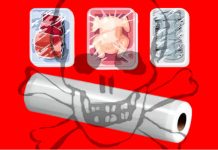Cling film for food very often contains PVC, a polymer that is hazardous to health and is expected to be banned soon. However, the market offers less problematic alternatives, as shown by our market research examining 12 plastic films for food.
1) Films with undeclared PVC
The packages food films report ‘miraculous tricks’ worthy of the worst television promotions, in terms of
– fully recyclable packaging (very simple with cardboard, regardless of the contents)
– ergonomic handle
– very efficient saw for precise film cutting.
Almost all of the producers however, in absence of obligation to indicate to consumers the material used to manufacture the films, it is careful not to specify the possible use of PVC.
A despicable omission, given that PVC presents clear risks for human health and the environment, as has been seen. (1)
2) Films with and without PVC, how to recognize them
To recognize the material with which plastic film for food is manufactured, when not specified on the label, there are two ways:
– read whether the environmental label indicates how to dispose of the film (cleaned from food residues). The indication ‘PVC 3’ implies, obviously, that it is PVC
– check whether the product is indicated as ‘suitable’ for contact with all foods. PVC, in fact, must not be used in contact with sauces and foods preserved in oily liquids or with foods entirely made up of animal or vegetable oils and fats.
3) Big brands, PVC
Cuki and Domopak, both owned by the German group Melitta, are the best-known brands in this type of food contact materials. Both seem to lean towards the use of PVC, but without providing timely information to consumers.
Home pack never specifies the material used in its film (‘super-sticky’ and ‘2 in 1’), not even in the environmental label of the packaging. The warnings – avoid contact with fatty foods – lead one to believe that it is PVC. Instead, it specifies the absence of phthalates and BPA.
Cuki in turn, in the environmental labeling of its ‘super-adherent’ film, it specifies the nature of the plastic (PET) and communicates the absence of phthalates and BPA. The website reports the existence of two other types of film, the ‘2 in 1’ and the ‘non-pvc’ version. Both are almost impossible to find in supermarkets and the company website, as usual, does not describe their characteristics.
Among the examined films, five others are PVC-based. As the table shows, the Eurospin ‘fridge and microwave’ packaging reveals the material in the environmental label. The Conad one clearly indicates, on the back of the packaging, ‘PVC film’. The other four films examined – Esselunga extra adherence, Lidl Aromata 2 in 1, Arkalia by Pam Panorama and Todis – do not report any information.

Survey November 2024
4) PVC-free films
Identifying PVC-free films it’s easier. This feature is usually highlighted on the front of the package, to highlight the absence of a dangerous plastic.
Among the five products the only exception examined is Eurospin which, in its ‘self-sealing’ film, reveals the nature of the plastic only in the environmental label: Separate collection, LDPE 04 low-density polyethylene.

5) Shopping (and supplies) tips
The producers of materials in contact with food, as well as large-scale retail trade groups, should become aware of their responsibility to place safe products on the market, pursuant to the General Product Safety Regulation (EU) 2023/998.
Such responsibility, as we have seen, implies the duty to carry out appropriate risk analyses connected to the materials used and the methods of use of all non-food products intended for the consumer. Taking into account not only the current regulations, which are still lacking in this area, but also the scientific evidence. (2)
Customers, in turn, should be careful to avoid the use of transparent PVC films, and in any case refrain from using them to wrap foods that contain fats (e.g. cheeses, pizzas, ready meals), in order to avoid exposure to toxic chemical substances that could migrate into them.
Waiting that the European Commission finally bans the use of PVC in materials intended to come into contact with food.
Marta Strinati and Dario Dongo
Footnotes
(1) Dario Dongo, Andrea Adelmo Della Penna. PVC, serious risks on transparent films and other packaging . GIFT (Great Italian Food Trade).
(2) Dario Dongo, Alessandra Mei. General Product Safety Regulation, at the starting tape in the European Union. THE ABC’S . FT (Food Times). 13.5.23









